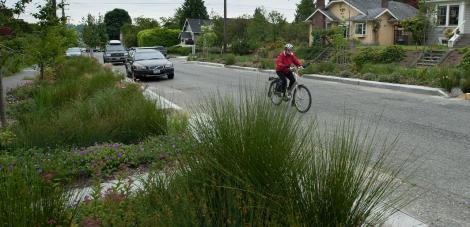Holes in your 'hood? SPU soil testing for roadside rain gardens
One of the successful roadside rain gardens already planted in Ballard
Mon, 04/08/2013
By Elizabeth Wang
If you’re wondering why there is a massive hole about eight feet deep on your block, you don’t need to be alarmed. Seattle Public Utilities (SPU) has begun phase two of the Ballard Natural Drainage System 2015 project, testing for pollutants in the runoff water collected underneath the soil from rain and other natural sources.
Between the blocks of NW 65th and NW 85th streets and 15th NW and 32nd NW avenues, the combined pipe, which collectively gathers the runoff water for the entire area has caused much of the neighborhood’s storm water overflow. The pollutants that are collected from the roads and sidewalks by the overflow eventually will drain into the Puget Sound.
Currently, Ballard is one of the biggest offenders of combined sewage overflow, creating approximately one third of the overflow problem in the city, according to Shanti Colwell, project manager of the natural drainage system.
In 2009, SPU came up with a concept to prevent the overflow from draining into the Sound through the use of roadside rain gardens built into the parking strips along residential sidewalks within these 20 blocks.
“Everything that comes off the roads, sidewalks is what we’re trying to capture,” Colwell said. “We would manage that water at a kind of level that eventually we can help to prevent the problem downstream. We started looking at kind of a high level and identified that this would be a good neighborhood to do natural drainage systems as part of the solution set.”
After Phase I of the project in 2010, many residents were left concerned about the continuation of the testing, confused as to why SPU was creating so many holes without much explanation of the drainage plans.
“We were moving really fast,” Colwell said. “We had a stimulus grant that required us to get everything designed in three months. We had some geotechnical information, but we did not have enough … We didn’t have enough time to work with the community and get them up to speed.”
Ken Bertrand lives a few blocks from the original testing sites but was not affected by Phase I of the project. He did, however, hear many of his neighbors complain about the giant holes in front of their houses. But with similar procedures in phase two, Bertrand is now mostly concerned about the aesthetic appeal to his block.
“I think they’re ugly,” he said of the existing rain gardens. “I like a nicely mowed green grass lawn. My main concern is that they look unkempt. They dug this huge hole and it just sat there for a whole year. It was just filled with water every time it rained.”
Others have also expressed concerns about standing water becoming pools of bacteria and toxins harmful to passersby, but the data collected so far doesn’t point in that direction.
“The data we’ve seen doesn’t support that,” Colwell said. “The levels that are coming off just from the street, the buildup of those toxins take a long time to get to the point of being toxic condition.”
Colwell also assured that SPU will be monitoring and replacing the top soil once everything is in place roughly every 15 years. She also said it will not so much be an inviting place for dogs or children to play in and the extra vegetation will protect the soil from easy access.
There is currently a successful roadside rain garden on 30th Ave NW that will be used as an example for the project to follow. As of now, phase two consists of sampling and data analysis.
Colwell said so far SPU knows something will be put in place in the year 2015 to help alleviate the overflow problem, but the location is still unknown. She hopes to set up another community meeting sometime in late May to early June to discuss the collected data with the community and the steps to continue forward.
Colwell added: “It’ll help the community if we can get this one installed well and they can see how it works and understand better kind of what it’s doing to help clean up the Puget Sound.”
Here is a map of the sites SPU will be soil testing. About six of them have changed, but otherwise the blocks and outlines are still accurate. (See the full map here, courtesy of the Ballard Stormwater Consortium.)
 Follow Ballard News-Tribune on Facebook at www.facebook.com/ballardnewstrib
Follow Ballard News-Tribune on Facebook at www.facebook.com/ballardnewstrib
And Twitter at http://twitter.com/ballardnewstrib


